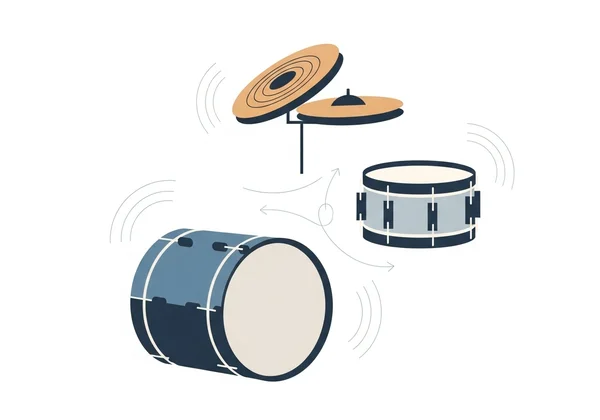Create Original Drum Patterns with Virtual Drums Online
Unleash your inner rhythm! Have you ever wanted to compose your own drum beats but thought it was too complicated or required expensive equipment? The good news? You can move beyond just playing along and start crafting unique, original patterns right from your browser! With our free virtual drums, the barrier to entry is gone. How to practice composing drums without a physical drum set? This guide will take you step-by-step from a rhythmic idea to a fully-fledged beat, completely free and instantly accessible.
Our platform empowers you to become a creator. You don't need a soundproofed room, a thousand-dollar kit, or complex software. All you need is a keyboard and the desire to make some noise. Let's dive in and explore how you can start your journey into beat-making today. Start creating your beat and discover the composer within you.

Understanding Original Drum Patterns: The Rhythmic Canvas
Before you can build a house, you need to understand the materials. Creating original drum patterns works the same way. Every great beat, from the simplest rock groove to the most complex jazz rhythm, is built on a foundation of core principles. Understanding these building blocks is the first step toward crafting rhythms that are uniquely yours. Forget complex music theory for a moment; it's all about feeling that pulse and knowing how to express it.
The rhythmic canvas is your playground. It consists of tempo (the speed), the core instruments (kick, snare, hi-hat), and the flair (toms and cymbals). By learning how each element contributes to the overall feel, you gain the power to create any groove you can imagine. Let's break down these essential components.
Deconstructing the Groove: Kick, Snare, and Hi-Hat Fundamentals
At the heart of nearly every modern drum beat, you'll find a lively conversation between three key players: the kick drum, the snare drum, and the hi-hat. Mastering their interplay is absolutely essential for learning drum beat basics.
-
The Kick Drum: This is the pulse. It provides the low-end thump that you feel in your chest. In most common beats (like 4/4 time), the kick often lands on beats 1 and 3, providing a steady, grounding anchor for the entire pattern.
-
The Snare Drum: This is the backbeat. The snare provides the sharp, cracking sound that makes you want to clap along. It typically lands on beats 2 and 4, creating a powerful contrast to the kick and driving the rhythm forward.
-
The Hi-Hat: This is the timekeeper. The hi-hats provide a consistent subdivision of the beat, often playing eighth notes (twice per beat) or sixteenth notes. They fill the space between the kick and snare, gluing the entire groove together with a steady "tss-tss-tss" sound.

Finding Your Tempo: Setting the Pace for Your Beat
Your drum tempo is the speed at which your pattern is played, measured in Beats Per Minute (BPM). Setting the right pace is crucial because it defines the entire mood and energy of your rhythm. A slow tempo around 60-80 BPM might feel relaxed, perfect for a ballad or a slow blues track. A mid-tempo groove from 90-120 BPM is the sweet spot for rock and pop. Pushing it to 130 BPM and beyond injects high energy, ideal for punk or dance music.
Before you start composing, think about the feeling you want to create. Is it laid-back or frantic? Heavy or light? Tapping your foot or humming a melody can help you find a natural rhythm pace. On our online drum kit, you can experiment with different tempos to hear how it transforms your beat.
Beyond the Core: Adding Toms and Cymbals for Flair
Once you have a solid kick-snare-hi-hat groove, it's time to add personality with toms and cymbals. These elements are the spices that make your beat interesting and dynamic. They are perfect for creating transitions, building excitement, and adding impactful accents.
Drum fills are short rhythmic phrases played on the toms that "fill" the space at the end of a musical section, signaling a change. A simple fill could be a quick run down the toms before a chorus kicks in. Cymbal patterns, like hitting a crash cymbal on beat 1, can add a powerful splash of energy to mark the start of a new measure. Don't overdo it; a well-placed crash or a simple tom fill can be far more effective than a constant flurry of notes.
Your Virtual Drum Composition Studio: Getting Started
Now that you understand the fundamentals, it's time to put them into practice. Our online platform is your personal studio for virtual drum composition. Our platform is designed to be intuitive, allowing you to translate the ideas in your head into audible rhythms without any friction. There’s no software to install or account to create. Just open the page, and you're ready to go.
This section will guide you through the practical steps of using our online tool to create your first beat. We'll cover how to use your computer keyboard as your instrument, lay down a foundational pattern, and add a human touch to make it sound authentic.
Mastering the Keyboard: Keys for Creative Drumming Online
Your computer keyboard is your new set of drumsticks. We've mapped each drum and cymbal to a specific key for an intuitive playing experience, turning your desk into a hub for music creation online. To see the layout, simply click the "Show Key" button on our virtual kit.
You'll quickly notice the logic. Keys are grouped for easy access, allowing you to use different fingers for different sounds, mimicking how a real drummer uses their hands and feet. For example, you might use one hand for the hi-hat and snare while the other handles the kick and toms. Spend a few minutes just hitting keys to familiarize yourself with the sounds and their locations. This muscle memory will be invaluable as you start composing.

Laying Down the Foundation: How to Create Your First Drum Beat Online
Let's build a classic rock beat. This is the first drum beat tutorial for countless drummers and it’s a pattern you’ve heard in thousands of songs. It’s simple, powerful, and a perfect starting point.
- Set the Hi-Hat: Start by playing a steady stream of eighth notes on the hi-hat. Just a constant, even "tss-tss-tss-tss."
- Add the Kick Drum: While keeping the hi-hat going, add the kick drum on beats 1 and 3. You should now hear "BOOM-tss-tss-tss-BOOM-tss-tss-tss."
- Add the Snare Drum: Finally, add the snare on beats 2 and 4. The full pattern will sound like: "BOOM-tss-CRACK-tss-BOOM-tss-CRACK-tss."
Congratulations, you've just created one of the most foundational beats in music! Practice it until it feels smooth. From here, you can experiment by moving the kick drum around or trying different hi-hat patterns.
Adding Dynamics: Making Your Virtual Drums Sound Alive
One thing that separates a robotic beat from a human one is dynamics. Real drummers don't hit every drum with the same force every time. Some notes are louder (accents), and some are softer (ghost notes). While you can't control velocity with a standard keyboard, you can simulate drum dynamics through clever composition.
To make your patterns feel more alive, try varying the rhythm slightly. Instead of just steady eighth notes on the hi-hat, try opening and closing the hi-hat for a "chick" sound. You can also create expressive drumming by adding very quiet, quick snare hits in between the main backbeats. These subtle additions create a sense of groove and prevent your patterns from sounding monotonous.
Advanced Techniques for Your Drum Pattern Generator
You've mastered the basics and created your first beat. Now, where do you go from here? Our platform is more than just a basic player; it's a powerful drum pattern generator for your imagination. This section introduces advanced techniques to help you break free from simple loops and start creating complex, engaging, and truly original rhythms.
These tips will help you add variation, build complexity, and, most importantly, find your unique rhythmic voice. The goal is to move from being a beat-maker to a true rhythm composer. So let's explore how to take your skills to the next level with our try our drum simulator.
Experimenting with Variations: Beyond Repetition
A great drum part evolves. It supports the song by changing slightly in different sections. The key is to introduce drum beat variations without losing the core groove. A simple way to do this is by altering the kick drum pattern. For example, instead of just hitting on beats 1 and 3, try adding an extra kick right before beat 3.
Another powerful technique is rhythmic displacement. Try shifting your entire snare pattern by one eighth note. This can create a syncopated, off-kilter feel that completely changes the mood of the beat. The goal is to keep the listener engaged by introducing small, unexpected changes that keep the rhythm fresh and exciting.
Layering for Richness: Building Complex Rhythms
To build complex drum beats, think in layers. Start with your foundational kick and snare pattern. Once that feels solid, layer a more intricate hi-hat pattern over it—perhaps using sixteenth notes or adding accents. After that, you can add another layer with the ride cymbal or a percussion instrument.
This method allows you to build dense, rich rhythmic textures without getting overwhelmed. You can also experiment with polyrhythms by layering two different time signatures, though this is a more advanced concept. The main idea is to start simple and gradually add layers of complexity, ensuring each new part serves the overall groove.
Finding Inspiration: Overcoming Creative Hurdles
Every creator hits a wall sometimes. When you need drumming inspiration, one of the best things you can do is listen actively to music. Don't just hear the drums; analyze them. What is the drummer doing? Try to replicate their beats on our virtual kit. This is a fantastic way to expand your rhythmic vocabulary.
Another great source of beat-making tips is to step away from drums entirely. Listen to the rhythm of a rapper's flow, the strumming pattern of a guitar, or the syncopation of a bassline. These can all inspire unique drum patterns that you might not have thought of otherwise. Use our virtual drum set as your musical sketchbook to quickly try out ideas whenever inspiration strikes.

The Art of Listening: Refining Your Original Patterns
Creating the beat is only half the battle; refining it is where the magic happens. After you've composed a pattern, step back and listen to it with a critical ear. Does it feel good? Does it groove? Is it too busy, or is it too simple? These are essential drum mix tips even without a mixer.
One of the best ways to practice beat refinement is to imagine it in the context of a full song. Does your pattern leave enough space for other instruments and vocals? A great drum part always serves the song. Record yourself playing and listen back. You'll often notice small timing issues or sections that could be improved. This process of listening and refining is what separates good drummers from great ones.
Your Journey to Original Drumming Starts Now!
From understanding the core elements of a groove to applying advanced compositional techniques, you now have the knowledge to create your own original drum patterns. The fear of cost, space, and complexity is no longer an obstacle. With just your keyboard and a browser, you have an entire drum kit at your fingertips, ready to bring your rhythmic ideas to life.
The key is to experiment, have fun, and embrace the creative process. Every beat you create is a step forward on your musical journey. Ready to start making noise? Unleash your inner drummer today and see what you can create.
Frequently Asked Questions About Creating Drum Patterns
Can you learn to create drum patterns online?
Absolutely! Online virtual drum tools provide the perfect risk-free environment to learn the fundamentals of rhythm and beat creation. Our platform gives you instant access to a full kit, allowing you to practice patterns, experiment with composition, and develop your timing without any financial investment.
How to play drums on a computer keyboard for composition?
It's incredibly intuitive. Each drum and cymbal on our virtual kit is mapped to a specific key on your computer keyboard. By familiarizing yourself with this layout (using the "Show Key" feature), you can use your fingers to tap out rhythms just as a drummer uses sticks. This method is perfect for quickly sketching out ideas and composing complex patterns.
What is the best virtual drum set for developing original beats?
The best virtual drum set is one that is accessible, responsive, and easy to use. Our virtual drum set is designed to be exactly that—a free, browser-based tool that lets you focus on creativity without getting bogged down by technical hurdles. Its realistic sounds and simple interface make it an ideal choice for anyone looking to play drums online and compose their own beats.
How to practice composing drums without a physical drum set?
Using an online drum simulator is the most effective way. It allows you to practice the fundamentals of rhythm, experiment with different patterns, and apply compositional techniques in real-time. You can work on your timing, learn how different parts of the kit interact, and build a library of your own original grooves, all from your computer or mobile device.